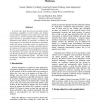Free Online Productivity Tools
i2Speak
i2Symbol
i2OCR
iTex2Img
iWeb2Print
iWeb2Shot
i2Type
iPdf2Split
iPdf2Merge
i2Bopomofo
i2Arabic
i2Style
i2Image
i2PDF
iLatex2Rtf
Sci2ools
ECBS
2004
IEEE
2004
IEEE
WASP: A Radio Geolocation System on Highly Resource Constrained Mobile Platforms
In recent years, there has been an increased need for surveillance capabilities in both civilian and military arenas. Mobile unmanned sensor fleets have long been envisioned as a tool for acquiring such intelligence. This paper describes a geolocation system as a payload for unmanned aerial vehicles. In particular, we address the issues that arise in designing an inexpensive, distributed, mobile, RF sensor processing system: low payload cost; power-limited components; real-time constraints; absence of common clocks; and varying environmental conditions. We also target, qualitatively, the tradeoff decisions across the dimensions of accuracy (of time of arrival estimates and the final geolocation), computational effort, physical dimensions, and operational logistics. The final system architecture, algorithms, and accuracy figures are also described.
| Added | 20 Aug 2010 |
| Updated | 20 Aug 2010 |
| Type | Conference |
| Year | 2004 |
| Where | ECBS |
| Authors | Kumar Chhokra, Ted Bapty, Jason Scott, Simon Winberg, Janos Sztipanovits, Don van Rheeden, Ben Abbott |
Comments (0)

